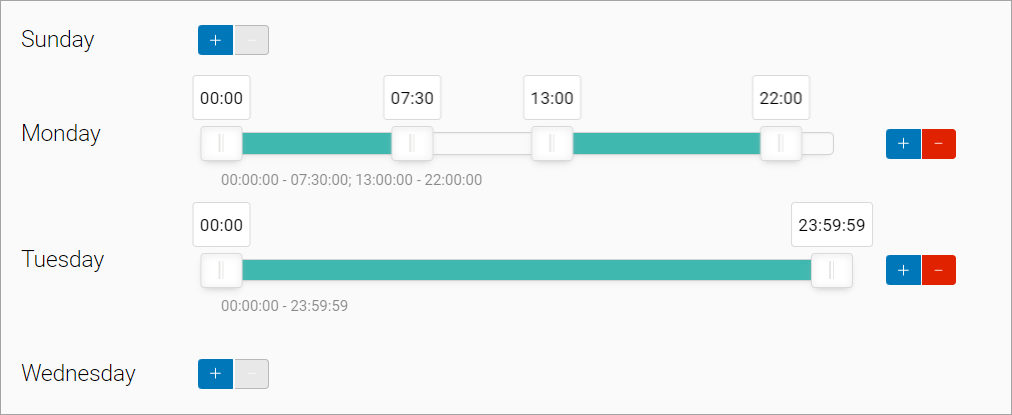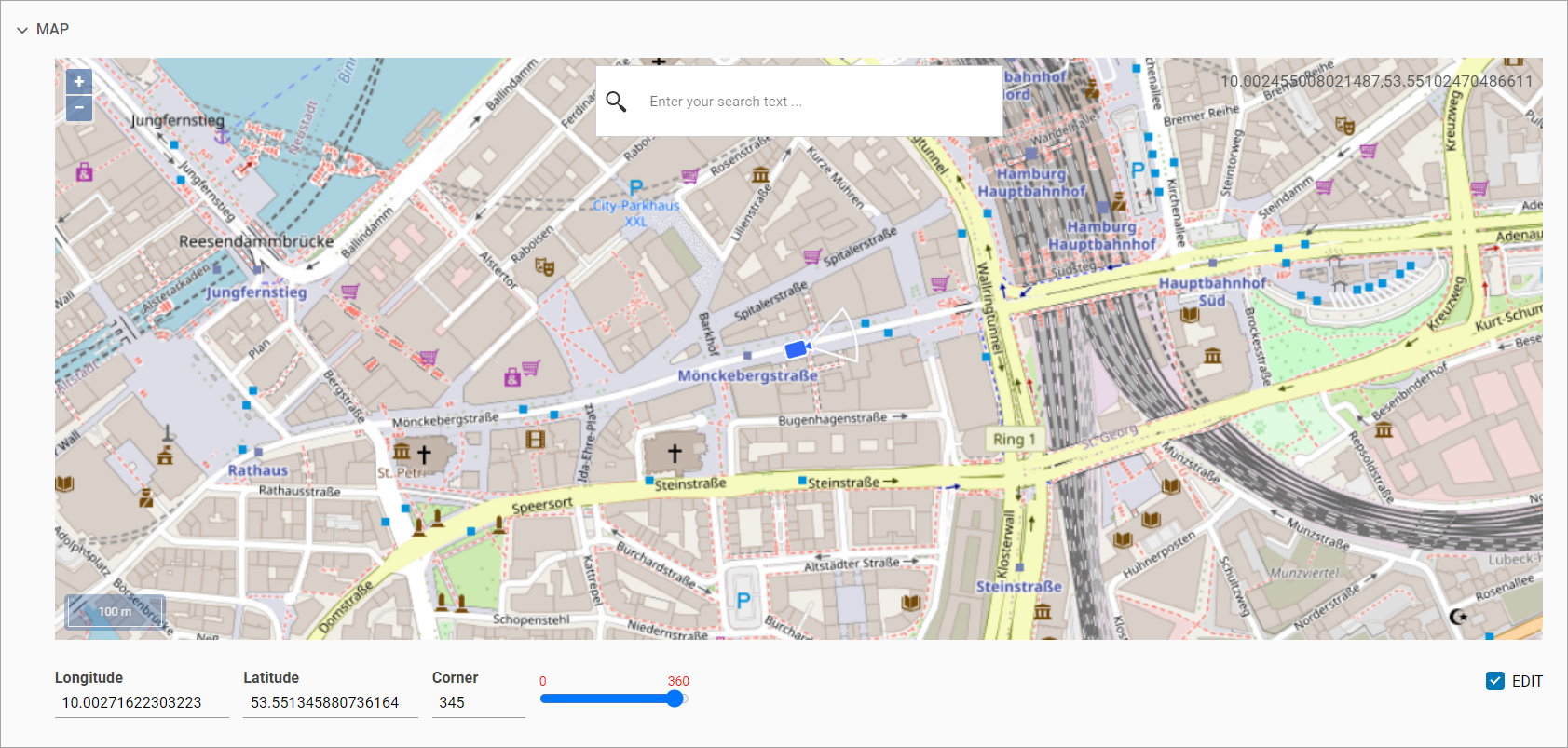General data
You can find general information about the camera and the control buttons at the top-right of each tab when viewing information about the camera.

The camera details and the control buttons
The general details are as follows:
The device type and camera ID in VMS. The ID is automatically assigned to a newly created camera.
The status of the camera can be one of the following values:
Active – both video streams of the camera are active.
Inactive – both video streams of the camera are inactive.
Initialization – the video streams have been initialized on the media server, but the media server has not yet responded regarding the capture of the video streams.
Partially active – one of the two video streams on the camera is inactive.
Empty – there are no video streams on the camera (the default value when the camera is added).
The list of added tags. You can edit the list. Automatic tagging is possible. Camera search by tags is also available on the Tags of cameras page.
The following camera control buttons:

The camera control buttons
Back. Selecting the icon brings you to the camera list of the location (group).
Stop archive recording. Selecting the icon s you stop archive recording.
Reload index. Select this option to refresh indexes, or reindex, a video stream after moving it from one media server to another.
It is recommended to reload indexes when issues with archive playback arise. Typically, such errors occur after the video streams from cameras have been moved between the platform’s media servers.
Reload. Select this option to reload the camera.
Delete camera.
The General data tab
The General data tab contains general details about the camera.
.png?inst-v=1d934989-adc9-47d4-b93e-1c2e7354ae81)
The General data tab
The top of the tab displays the following information:
The camera IP address.
The reservation status of the IP address on the DHCP server:
Reserved – the IP address is reserved on the DHCP server.
Unreserved – the IP address is not reserved on the DHCP server.
The date and time when the camera was created.
The camera creation method:
auto – the camera was automatically added to the system.
manual – the camera was manually added to the system.
The details of the camera:
The camera name.
The Media server groups.
You can find a detailed description of media server groups on the Media Server Groups documentation page.
You can select media server groups only before camera video streams are added.
Number of days the archive was stored. Enter a number of days for archive storage.
The number of days should start from 1.
For cameras that are added manually, the default value is set to 1 day. This value can be edited, provided the corresponding access right is granted.
For cameras that are added automatically, the system sets the value based on the customer’s specifications, and it cannot be modified.
Services:
Motion detection. This option can be selected for cameras with the motion detection function. Selecting this service enables the Recording by event option under Recording archive.
Add user. Here, you can select a user who will have access to camera schedule settings. The option is available only when the current administrator has the relevant level of permissions to manage users. You can select the user from the list who have access to the camera (For details, see the Users documentation section). When a user is selected, the Recording archive settings become unavailable. In this case, the assigned user performs all the settings in their web interface. When the user changes the schedule, the administrator automatically receives a notification about the schedule change. If the user is added and the changes are updated, the Go to owner option becomes available under User. You can select this option to navigate to the page that contains the details of this user.
Recording archive. This setting is available for modification when no user is specified in the previous step. Only one option can be selected:
Select the radio button of the archive recording parameter:
Recording full-time. You set recording video continuously, without any breaks.
Recording timetable. Recording is performed according to the set schedule.
Recording by event. This option is only available when the Motion detection service is enabled. Selecting this option starts archive recording when motion is detected by the camera. The archive recording starts when an event is detected and continues for three minutes.
Configuration of motion detection events is performed in the camera management web interface.

Configuring the schedule of archive recording
If a user from a different time zone set the schedule, you’ll see a corresponding message. If you edit the schedule, it will be adjusted according to your current time zone.
Address. The field can’t be edited. The added addresses are helpful to search for a camera in the camera tree. The address is prefilled automatically as you add a camera to a specific location.
Optionally, you can add more addresses. This camera, in such a case, will be available to the users at the all added addresses. In this case, a special icon indicates the camera in the list.
.png?inst-v=1d934989-adc9-47d4-b93e-1c2e7354ae81)
The camera with a special icon
Buffered streams – the setting is applied for simultaneous server buffering of RTSP streams that are added to the camera. The setting is applied to the Media server.
Archive recording stopped/Archive recording in progress are the informational indicators that display the status of the archive recording. When recording starts, the indicator changes to Archive recording in progress.
Sound enabled. The option is for cameras with sound recording capability. With this setting enabled, the audio stream is processed, recorded, and played back together with the camera video stream.
Camera with limited access. Selecting this setting enables a notification on the View in player tab. This notification will indicate that restricted access is now in effect. Consequently, all actions will be recorded in the log.
Intercom’s camera. This setting is displayed when the intercom module is connected and the user has the corresponding permissions. With this setting enabled, the camera can be selected as an intercom camera during its configuration (see the View and edit intercom documentation section). When viewing the camera tree and on the search page of intercoms, intercom cameras are indicated by a special icon. You can see the Open the player on the intercom page button at the top right of the camera details page along with other management buttons, if this camera is selected as an intercom camera on the View in player tab on the intercom details page. Selecting this button will redirect you to the intercom details page, exactly to the View in player tab.

The Open the player on the intercom page button
Increased reconnection time. When this setting is enabled, the number of reconnections required to assign the camera the Problematic and Disconnected statuses is increased. A detailed description of the algorithm is provided in the Incorrect cameras section.
External access. Enable this option to set restrictions to access the camera. To allow access to the camera from a specific subnet, select Add subnet and specify an IP address and subnet mask. If the setting is enabled, but subnet fields aren’t completed, access to the camera won’t be restricted.
Set a schedule for SMTP motion detection on each day, if required. You have the flexibility to set multiple time periods within a single day. In case a schedule is not set for a particular day, the system will default to detecting SMTP motion continuously throughout that day.

Set a schedule
Network device. It is displayed when the camera is automatically added. Contains the details about the camera from the customer's billing system.
Profile camera. Displayed when the camera is automatically added. Contains information about the camera from the Customer's billing system. The profile update function is available.
You can specify the camera location on the map. To do this:
Enable the Edit setting under the map.
To specify the location on the map, left-click on the map or complete the Longitude and Latitude fields under the map.
Adjust the camera rotation angle with the slider or complete the Corner field.

The camera location on the map
Select Save.
